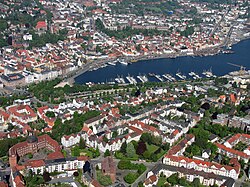Flensborg
| Flensburg, Germany | ||
|---|---|---|

Flensburg Harbour in 2012
|
||
|
||
| Coordinates: 54°46′55″N 09°26′12″E / 54.78194°N 9.43667°ECoordinates: 54°46′55″N 09°26′12″E / 54.78194°N 9.43667°E | ||
| Country | Germany | |
| State | Schleswig-Holstein | |
| District | Urban district | |
| Government | ||
| • Lord Mayor | Simon Faber (SSW) | |
| Area | ||
| • Total | 56.38 km2 (21.77 sq mi) | |
| Elevation | 12 m (39 ft) | |
| Population (2015-12-31) | ||
| • Total | 85,942 | |
| • Density | 1,500/km2 (3,900/sq mi) | |
| Time zone | CET/CEST (UTC+1/+2) | |
| Postal codes | 24901–24944 | |
| Dialling codes | 0461 | |
| Vehicle registration | FL | |
| Website | www.flensburg.de | |
| Significant minority groups | |
| Nationality | Population (2014) |
|
|
2,305 |
|
|
861 |
|
|
737 |
|
|
255 |
|
|
250 |
|
|
155 |
Flensburg (Danish: Flensborg, Low Saxon: Flensborg, North Frisian: Flansborj, South Jutlandic: Flensborre) is an independent town (kreisfreie Stadt) in the north of the German state of Schleswig-Holstein. Flensburg is the centre of the region of Southern Schleswig. After Kiel and Lübeck it is the third largest town in Schleswig-Holstein.
In May 1945, Flensburg was the site of the last government of Nazi Germany, the so-called Flensburg government led by Karl Dönitz, which was in power from 1 May (The announcement of Hitler's death) for one week until German armies surrendered and the town was occupied by Allied troops. The regime was officially dissolved on 23 May.
The nearest larger towns are Kiel (86 kilometres (53 miles) south) and Odense in Denmark (92 km (57 mi) northeast). Flensburg's city centre lies about 7 km (4 mi) from the Danish border.
In Germany, Flensburg is known for
Flensburg is situated in the north of the German state Schleswig-Holstein, on the German-Danish border. After Westerland on the island of Sylt it is Germany's northernmost town. Flensburg lies at the innermost tip of the Flensburg Fjord, an inlet of the Baltic Sea. Flensburg's eastern shore is part of the Angeln peninsula.
...
Wikipedia


